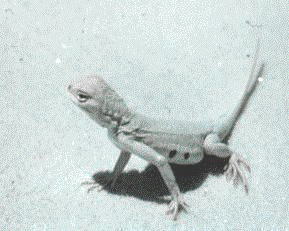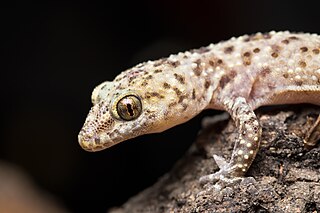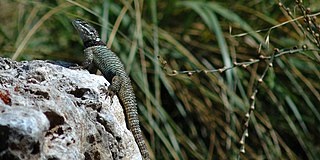
The greater earless lizard is the only species in the monotypic genus Cophosaurus. It is closely related to the smaller, lesser earless lizards and other species in the genus Holbrookia, and in fact was placed in that genus and referred to Holbrookia texana from 1852 into the 1970s. Earless lizards lack external ear openings, an adaptation to burrowing in the sand, as are the recessed lower jaw and flared upper labial scales. Greater earless lizards are sexually dimorphic, males grow larger and are more colorful than females, exhibiting pink and green colors that are particularly bright in the breeding season. Two bold black bars mark the lateral region of males but are greatly reduced and vague, or occasionally entirely absent in females.

Scincella is a genus of lizards in the skink family, Scincidae, commonly referred to as ground skinks. The exact number of species in the genus is unclear, as taxonomic reclassification is ongoing, and sources vary widely. Scincella species primarily range throughout the temperate regions of the world and are typically small, fossorial lizards, which consume a wide variety of arthropods. They are a generalized insectivore with well developed chemosensory abilities.

The Mexican blind lizard is a species of legless lizard in the family Dibamidae, and the only species in the genus Anelytropsis. It is endemic to Mexico. They look like Amphisbaenia, but are in fact, only distantly related.

Holbrookia is a genus of earless lizards, known commonly as the lesser earless lizards, in the family Phrynosomatidae. The genus contains six recognized species, which are found throughout the Southwestern and Central United States and northern Mexico. They are characterized by having no external ear openings, presumably to prevent soil from entering their bodies when they are digging.

The Texas tortoise is a species of tortoise in the family Testudinidae. The species G. berlandieri is one of six species of tortoises that are native to North America.

Sceloporus poinsettii, the crevice spiny lizard, is a species of small, phrynosomatid lizard.

The Mediterranean house gecko is a species of house gecko native to the Mediterranean region, from which it has spread to many parts of the world including parts of East Africa, South America, the Caribbean, and the Southern and Southeastern United States. It is commonly referred to as the Turkish gecko as represented in its Latin name and also as the moon lizard because it tends to emerge in the evening.

Agkistrodon taylori is a species of venomous snake, a pitviper (Crotalinae) found only in northeastern Mexico. The standardized names are Taylor's cantil (English) and Metapil (Spanish), although it is sometimes called the ornate cantil as well as several other colloquial names. It was named in honor of American herpetologist Edward Harrison Taylor.

The northern sheep frog is native to Central America, Mexico, and extreme south Texas, United States. It occurs in the lowlands from Sonora, Mexico, to northern Costa Rica on the Pacific coast, and south Texas to Honduras on the Gulf of Mexico and Caribbean coasts. The sheep frog inhabits semiarid thornscrub, savannas, pasturelands, and open woodlands, as well as more humid, moist forest in the canyons, basins, foothills, and lower elevations of mountains slopes. It is a fossorial, burrowing frog that is seldom seen on the surface except at night after heavy rains when they emerge to breed. The sheep frog gets its name from its distinctive call that resembles a sheep's bleat. It is a diet specialist primarily feeding on termites and ants.

Scincella lateralis, formerly Lygosoma laterale is a small species of skink found throughout much of the eastern half of the United States, and into northern Mexico. The ground skink differs from the majority of North American lizard species in that it is generally considered a forest dweller. Common names for this species include the little brown skink and the ground skink. However, the common name, ground skink, may refer to any species in the genus Scincella.
Hobart Muir Smith, born Frederick William Stouffer, was an American herpetologist. He is credited with describing more than 100 new species of American reptiles and amphibians. In addition, he has been honored by having at least six species named after him, including the southwestern blackhead snake, Smith's earth snake, Smith's arboreal alligator lizard, Hobart's anadia, Hobart Smith's anole, and Smith's rose-bellied lizard. At 100 years of age, Smith continued to be an active and productive herpetologist. Although he published on a wide range of herpetological subjects, his main focus throughout his career was on the amphibians and reptiles of Mexico, including taxonomy, bibliographies, and history. Having published more than 1,600 manuscripts, he surpassed all contemporaries and remains the most published herpetologist of all time.

Aquiloeurycea galeanae, commonly known as the Galeana false brook salamander, is a species of salamander in the family Plethodontidae. It is endemic to north-eastern Mexico and known from higher elevations in the Sierra Madre Oriental of southern Nuevo León as well as adjacent Coahuila and Tamaulipas.

Ctenosaura acanthura, is a species of iguanid lizard found in eastern Mexico and extreme western Guatemala. The standardized English name is the Mexican spiny-tailed iguana. Confusingly however, an earlier edition of standardized names for Mexican herpetofauna called Ctenosaura acanthura the northeastern spinytailed iguana and applied the name Mexican spinytailed iguana to Ctenosaura pectinata, which was called the western spiny-tailed iguana in the second edition. It has also been referred to as the Veracruz spiny-tailed iguana and Gulf Coast spiny-tailed iguana. It is an egg laying species that is mostly herbivorous and a moderately large lizard commonly growing over one meter in total length.

Scincella gemmingeri, commonly known as the forest ground skink, Cope's forest ground skink, and la escíncela de bosque de Cope in Mexican Spanish, is a species of lizard in the family Scincidae. The species is endemic to Mexico.

The El Cielo Biosphere Reserve is located in the Sierra Madre Oriental in the southern part of the Mexican state of Tamaulipas near the town of Gómez Farias. The reserve protects the northernmost extension of tropical forest and cloud forest in Mexico. It has an area of 144,530 hectares made up mostly of steep mountains rising from about 200 metres (660 ft) to a maximum altitude of more than 2,300 metres (7,500 ft).
Scincella forbesorum, also known commonly as Forbes' forest ground skink and la escíncela de bosque de Forbes in Mexican Spanish, is a species of lizard in the family Scincidae. The species is endemic to Mexico.

Plestiodon dicei, or Dice's short-nosed skink, is a species of lizard which is endemic to Mexico. It was named in honor of Lee R. Dice, who collected the holotype in 1930 while conducting a faunal survey in the Sierra de San Carlos, Tamaulipas, Mexico. It was considered a subspecies of Plestiodon brevirostris for many decades. Plestiodon dicei occurs in northeastern Mexico, in the Sierra Madre Oriental in Coahuila, Nuevo Leon, San Luis Potosi, and Tamaulipas, with isolated populations in the Sierra de San Carlos and the Sierra de Tamaulipas.

Sceloporus mikeprestoni, Preston's torquate lizard, is a species of lizard in the family Phrynosomatidae. It is endemic to Mexico.
Barisia ciliaris, also known commonly as the Sierra alligator lizard, the imbricate alligator lizard, and el escorpión de montaña in Mexican Spanish, is a species of medium-sized lizard in the family Anguidae. The species is endemic to Mexico.
Heterodon kennerlyi, also known commonly as the Mexican hognose snake, Kennerly's hog-nosed snake, and la trompa de cerdo mexicana in Mexican Spanish, is a species of snake in the subfamily Dipsadinae of the family Colubridae. The species is native to the southwestern United States and adjacent northeastern Mexico















